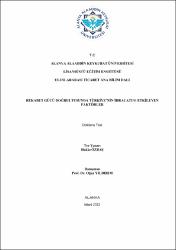| dc.contributor.advisor | Yıldırım, Oğuz | |
| dc.contributor.author | Özbaş, Hakkı | |
| dc.date.accessioned | 2022-06-17T13:29:20Z | |
| dc.date.available | 2022-06-17T13:29:20Z | |
| dc.date.issued | 2022 | en_US |
| dc.date.submitted | 2022-03-02 | |
| dc.identifier.uri | https://hdl.handle.net/20.500.12868/1510 | |
| dc.description.abstract | Uluslararası ticarette yaşanan gelişmeler, ülkelerin ihracat pazarlarında yoğun bir
rekabetle karşı karşıya kalmasına neden olmuştur. Geleneksel ticaret teorilerinin maliyet/fiyat
temelli rekabet yaklaşımının günümüz uluslararası ticari ilişkilerini açıklama konusunda
yetersiz kalması, rekabet gücü elde edebilmek için maliyet/fiyat üstünlüğü dışındaki
faktörlerinde ele alınmasını gerektirmektedir. Yapılan bu çalışmada Türkiye’nin ihracattaki
rekabet gücünün tespit edilmesi amacıyla ticaret sonrası verileri kullanan ölçüm
yöntemlerinden Balassa tarafından oluşturulan açıklanmış karşılaştırmalı üstünlükler
yönteminin yanı sıra açıklanmış karşılaştırmalı üstünlükler yönteminin eksiklerini gidererek
yeni türevleri Vollrath tarafından geliştirilen rekabet gücü ölçüm yöntemleri kullanılmıştır.
Rekabet gücü ölçümlerinden elde edilen veriler doğrultusunda belirlenen ihracat mallarının
talebini etkileyebileceği düşünülen makroekonomik faktörler tespit edilmeye çalışılmıştır. Bu
maksatla bağımlı değişken olarak rekabet gücü ölçümlerinden elde edilen veriler doğrultusunda
belirlenen iki mal grubu ile iki model kapsamında ihracat talep fonksiyonu beşerî sermaye, reel
döviz kuru, yurt dışı gelir düzeyi, nispi ihracat fiyatı ve gayrisafi sabit sermaye yatırımı
açıklayıcı değişkenleri ile tahmin edilmeye çalışılmıştır. 2001-2019 yıllarını kapsayan dönemde
ihracat ile açıklayıcı değişkenler arasındaki ilişkileri tespit etmek için ARDL sınır testi ve Toda Yamamoto nedensellik analizleri yapılmıştır. Çalışma sonucunda iki ihracat grubu açısından
uzun dönem ve nedensellik ilişkisi bakımından en önemli faktörün beşerî sermaye olduğu
görülmüştür. Ayrıca reel döviz kurunun da iki ihracat grubunu uzun dönemde etkilediği
bulgusuna erişilmiş olup yurt dışı gelir düzeyi, gayrisafi sabit sermaye yatırımı ve nispi ihracat
fiyatı açıklayıcı değişkenlerinin etkilerinin ve nedensellik ilişkilerinin, oluşturulan iki mal
grubu açısından farklılık gösterdiği sonucuna varılmıştır. | en_US |
| dc.description.abstract | Developments in international trade have caused countries to face intense competition
in export markets. The inadequacy of the cost/price-based competition approach of traditional
trade theories in explaining today's international trade relations requires consideration of factors
other than cost/price advantage in order to gain competitiveness. In this study, in order to
determine Turkey's competitiveness in exports, the disclosed comparative advantage method
created by Balassa, one of the measurement methods using post-trade data, as well as the
competitive power measurement methods developed by Vollrath, its new derivatives, were used
by eliminating the deficiencies of the disclosed comparative advantages method. It has been
tried to determine the macroeconomic factors that are thought to affect the demand of export
goods determined in line with the data obtained from competitiveness measurements. For this
purpose, the export demand function was tried to be estimated with the explanatory variables
of human capital, real exchange rate, foreign income level, relative export price and gross fixed
capital investment within the scope of two models with two goods groups determined in line
with the data obtained from competitiveness measurements as dependent variables. ARDL
bounds test and Toda-Yamamoto causality analyzes were conducted to determine the
relationships between export and explanatory variables in the period covering 2001-2019. As a
result of the study, it has been seen that the most important factor in terms of long-term and
causality relationship for the two export groups is human capital. In addition, it was found that
the real exchange rate also affected the two export groups in the long run, and it was concluded
that the effects of the explanatory variables of foreign income level, gross fixed capital
investment and relative export price and the causality relations differ in terms of the two goods
groups | en_US |
| dc.language.iso | tur | en_US |
| dc.publisher | Alanya Alaaddin Keykubat Üniversitesi,Lisansüstü Eğitim Enstitüsü | en_US |
| dc.rights | info:eu-repo/semantics/openAccess | en_US |
| dc.subject | Rekabet gücü | en_US |
| dc.subject | Açıklanmış karşılaştırmalı üstünlükler | en_US |
| dc.subject | İhracat | en_US |
| dc.subject | ARDL sınır testi | en_US |
| dc.subject | Toda-yamamoto nedensellik analizi | en_US |
| dc.subject | Competitiveness | en_US |
| dc.subject | Revealed comparative advantages | en_US |
| dc.subject | Export | en_US |
| dc.subject | ARDL boundary test | en_US |
| dc.subject | Toda-yamamoto causality analysis | en_US |
| dc.title | Rekabet gücü doğrultusunda Türkiye’nin ihracatını etkileyen faktörler | en_US |
| dc.title.alternative | Factors affecting Turkey's exports in line of competitiveness | en_US |
| dc.type | doctoralThesis | en_US |
| dc.contributor.department | ALKÜ, Enstitüler, Lisansüstü Eğitim Enstitüsü, Uluslararası Ticaret Ana Bilim Dalı | en_US |
| dc.relation.publicationcategory | Tez | en_US |


















